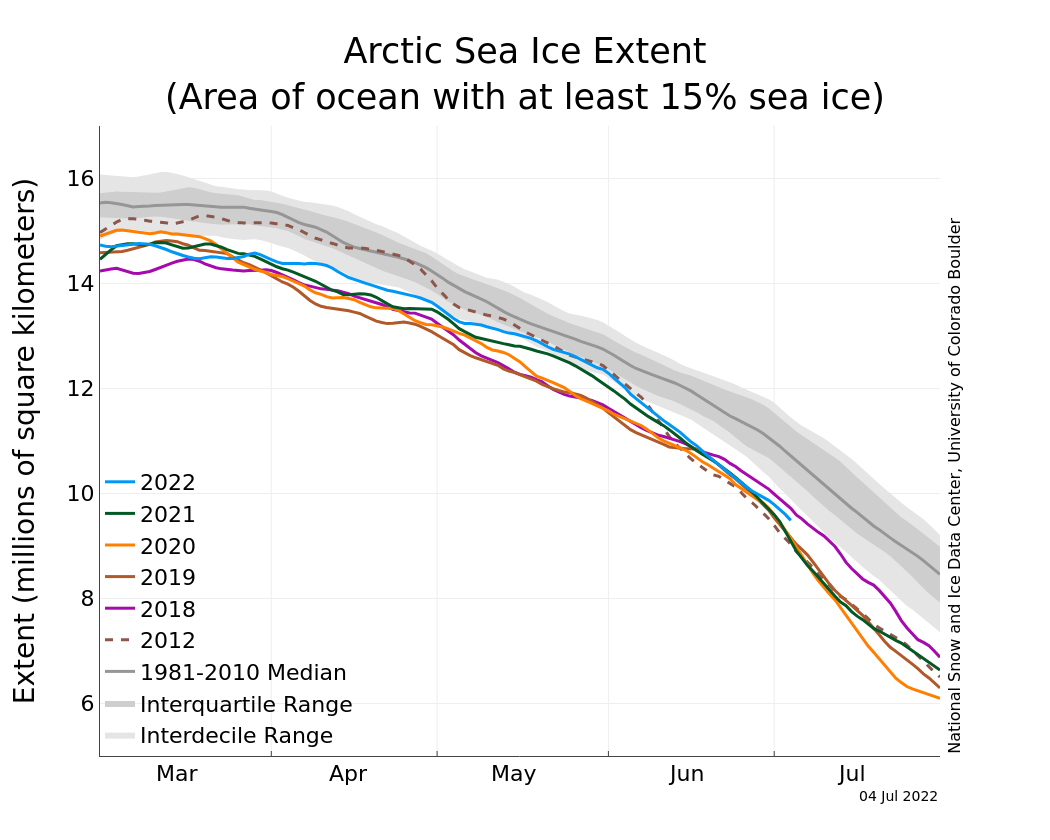Riding on the success of the Arctic winter 2021/2022 intervention that concluded at the end of March 2022 to increase ice levels, Kyrios has been attempting since April 2022 to reduce ice melt to bolster multiyear ice in the Arctic sea during 2022’s summer season by preventing air temperatures from rising too high. Multiyear ice is ice that has survived at least one summer melting season, and which becomes thicker and more melt-resistant over time. Retaining more ice through summer would set the stage for higher sea ice extent and volume in the subsequent Arctic winter season.
Kyrios’ endeavour has led to a slow down in sea ice loss as the melting season began. Despite the severe heat wave in mid March, Arctic sea ice extent in April maintained at levels higher than the last 7 years throughout the month. In May, seasonal sea ice loss was also slower compared to recent years, supported by lower air temperatures that were closer to the 1981 to 2010 average. Arctic sea ice extent in May tracked above levels not seen since 2013. June air temperatures over the Arctic were also close to the long-term average.
In terms of ice volume, data from the Danish Meteorological Institute shows that Arctic sea ice volume has continued to stay at levels above the past 2 years and within the 2004 to 2013 interdecile range since Kyrios began the Arctic intervention back in August 2021.
There is urgency in this undertaking as researchers have recently warned that the Arctic has already lost 95% of its thick multiyear sea ice since 1985. Arctic sea ice greater than 4 years old now makes up only 3.1% of ice cover – a record low. 2021 was especially bad. At the start of August 2021, multiyear ice covered just 1.6 million sq km. This graphic by Zack Labe illustrates the loss of sea ice thickness from 1979 to 2016.
Unfortunately, scientists expect Arctic sea ice to continue declining, and estimate that the Arctic Ocean could be ice-free in the summer by 2030. This is bad news for the world, as ice and snow reflect a high proportion of the sun’s energy back into space – a process known as the albedo effect – thus keeping the planet cool. Without ice cover, exposed bare rock and water absorbs the sun’s energy and warms, generating a feedback loop that leads to more ice melt.
Retaining as much Arctic ice during the summer season will also support Kyrios’ ongoing intervention to save Antarctic ice. Kyrios explains that this is because temperatures of the Arctic sea waters affect the temperatures of deep ocean waters that flow southwards from the Arctic Ocean to the Southern Ocean around Antarctica as part of the thermohaline circulation. Presently, warm deep ocean waters are melting Antarctic glaciers such as the Thwaites Glacier and Totten Glacier at accelerated rates. If left unchecked, the loss of ice mass across glaciers in the Antarctic ice sheet would cause sea levels to rise by several metres.
As Kyrios attempts to preserve Arctic ice during the 2022 summer melt season, we will report on new developments on Kyrios.com. Follow us on Instagram, Twitter as well as our YouTube channel for more information about Kyrios’ work!

